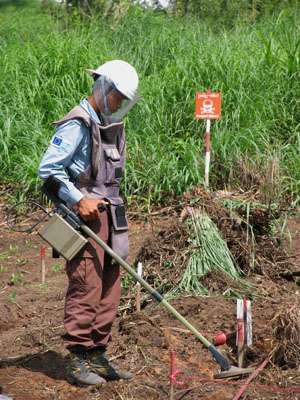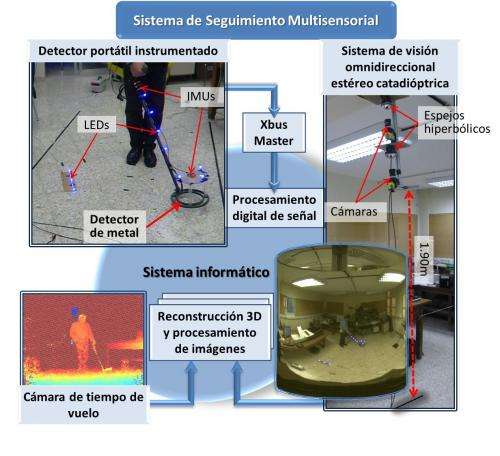A new tool to enhance tasks of humanitarian demining

Researchers at the Centre for Automation and Robotics, a joint centre of the Universidad Politecnica de Madrid and the Spanish National Research Council (UPM-CSIC), have developed a training tool to improve the use of hand-held detectors in humanitarian demining and to increase user security.
The proposed tool opens a wide range of possibilities, particularly to improve the current training techniques used in this field. In the first place, this tool has allowed researchers to study expert operators in order to quantify certain indicators that can be used later as reference values during training sessions. Secondly, it enables experts to assess new operators by providing relevant information to improve the skill of the tool during training sessions.
Landmines and other abandoned explosive ordnance are part of sad legacy of many conflicts. These devices can remain active during decades threating humans in the affected areas and depriving them of their lands and resources.
Today, a huge part of these tasks of humanitarian demining are still conducted by using hand-held detectors, particularly, metal detectors, though other detectors are being introduced gradually. They are based on new technologies such as nuclear resonance, geo-radars and explosive chemical detectors.
Although the design of new sensors can contribute to reduce the time needed to detect a landmine, it does not mean that it increases operator safety responsible for the demining tasks because a mere mistake can cost them their lives. For this reason, training is an essential aspect when we refer to enhance security and efficiency of demining tasks.

The research carried out by the Centre for Automation and Robotics CSIC-UPM, within the European Project of the Seventh Framework Programme, TIRAMISU (Toolbox Implementation for Removal of Anti-personnel Mineles, Submunitions and UXO) have resulted in a monitoring tool capable of analyzing the performance of operators of portable detectors of landmines.
The tool consists of a human-machine interface and a sensory tracking system of monitoring for hand-held detectors based on inertial measurement units, a system of catadioptric stereo omnidirectional vision and a flight time chamber. This tool can be easily adapted to be used with any type of hand-held detector and can be used to acquire information in two different scenarios.
Firstly, the tool can be used to study abilities of experts in different environments and with different types of hand-held detectors. From the information compiled we can extract, asses and quantify some critical variables for the performance, so that they can be used later as reference values during trainings and courses. Amongst these variables we can highlight the advance distance detector, the sweep velocity, the scan height and the inclination of the hand-held detector head with respect to the ground. Secondly, this tool can be used to assess the efficiency of operators in information process, feeding back the information in real time to enhance their skills during training sessions.
Accordingly, the proposed tool will allow researchers to develop and to implement new training methodologies based on scientific analysis of problems and the educational evaluation.
More information: Fernandez, R; Montes, H; Salinas, C; Gonzalez de Santos, P; Armada, M. Design of a training tool for improving the use of hand-held detectors in humanitarian demining. Industrial Robot-An International Journal 39 (5): 450-463. DOI: 10.1108/01439911211249742 . Pub. 2012.
Provided by madrimasd


















